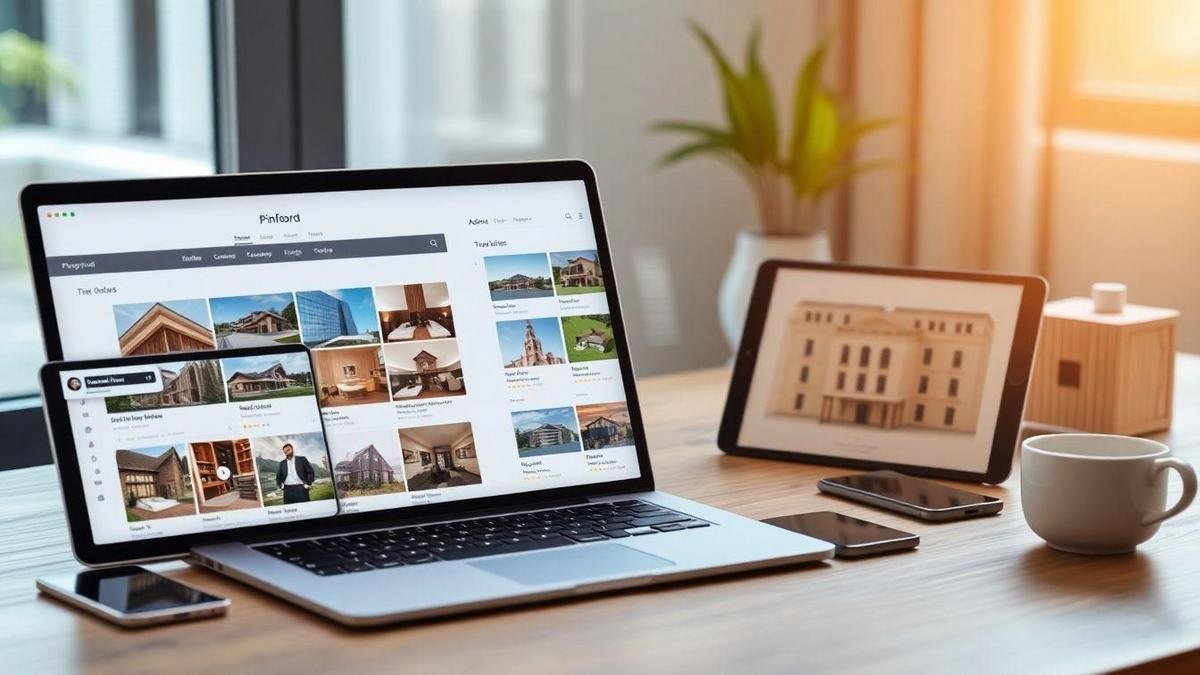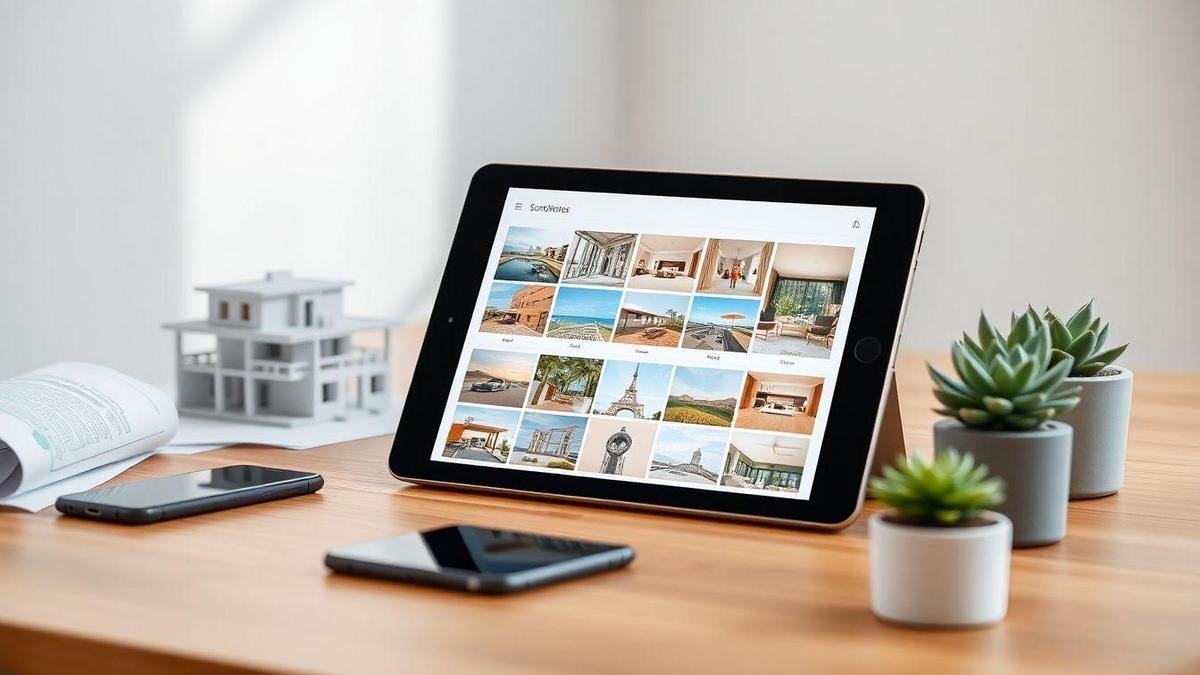Pinterest marketing for property developers — Turn images into buyers
Pinterest marketing for property developers shows how to turn visuals into discovery, traffic, and qualified leads. Developers will learn to set up a verified business profile, design showstopping pins and boards, use Pinterest SEO, run promoted pins, read analytics, and convert pin traffic into buyer leads. This guide is practical, concise, and ready to use.
Key takeaways
- Use bright, high-quality photos and mobile-first layouts.
- Keep a consistent brand style across pins and boards.
- Use local, searchable keywords and clear CTAs.
- Link pins directly to listings or short lead pages.
- Test with analytics and scale winners.

Why Pinterest marketing for property developers boosts discovery and leads
Pinterest is a visual search engine and inspiration platform. Pinterest marketing for property developers places projects where buyers already look for ideas, so strong images plus the right keywords increase discovery and produce qualified leads.
- High-intent visuals: users pin properties when imagining living there.
- Long shelf life: pins can drive traffic months later.
- Visual search: keyword-aligned images surface in search and related pins.
Developers who post lifestyle imagery, floorplans, and short walkthroughs convert browsers into inquiries by making information easy to find and beautiful to view. Consider professional aerial and staged photos to elevate pin performance (drone photography for real estate).
How developers reach homebuyers with visual search
Visual search matches image intent to user queries. Apply these practical steps:
- Use clear, bright photos of interiors, exteriors, and amenities.
- Add small text overlays with price ranges, neighborhood, or unit type.
- Write keyword-rich, natural descriptions for each pin.
- Create boards by buyer type (first-time buyers, investors, families).
Example: a staged living room labeled Modern 2BR near downtown will match searches like city 2BR modern and drive tour requests.
Main benefits for property marketing on Pinterest
- Higher visibility: appears in search and feeds for both active and passive buyers.
- Better targeting: keywords and interests reach specific buyer groups.
- Traffic that converts: visual appeal increases click-throughs to listings.
- Longevity and low ad friction: promoted pins blend with organic content.
Track saves, clicks, and conversions to refine offers and follow-up messaging — integrate those findings into broader ROI tracking and channel planning (measuring real estate marketing ROI).

How to set up an optimized Pinterest account for property developers
Treat your Pinterest presence like a polished showroom. Pinterest marketing for property developers works best when the account is tidy, verified, and trackable.
Profile, verification, and essentials
- Create or switch to a business account (analytics, ads, features).
- Use a professional company email and add a clear profile photo (logo or headshot).
- Claim and verify your website (Settings → Claim).
- Install the Pinterest Tag for conversion tracking and remarketing.
- Turn on two-step verification and claim related social profiles.
- Activate rich pins if your listings have structured data.
Branding and contact settings
- Display name: Brand name short keyword (e.g., Atlas Homes — City Flats) — align this with your broader real estate branding strategy.
- Bio: 1–2 sentence value pitch including keywords like urban apartments, or sustainable homes.
- Contact: list business email, phone (if used), and verified website.
- Boards: create covers matching brand palette and pin high-quality photos and floorplans.
Profile field recommendations:
| Field | Recommended entry |
|---|---|
| Profile photo | Company logo or professional headshot |
| Display name | Brand keyword (e.g., Atlas Homes — City Flats) |
| Bio | Value pitch with keywords CTA |
| Website | Verified corporate website |
| Contact | Business email, phone, location |
| Boards | Location, project, interiors, finishes, testimonials |
Account setup checklist:
- Business account, profile photo, keyword bio
- Claim and verify website, install Pinterest Tag
- Two-step verification, connect socials
- Create keyword-rich boards, pin high-res assets
- Grant analytics/ad access to marketing team

Content pillars and Pinterest content ideas for property developers
Core pillars: Inspiration, Education, Listings & Tours, Before & After, Lifestyle, Team & Process, Proof & Offers. Mix video, carousels, and static images.
Pins to create
- Video tour pins (30–60s walkthroughs).
- Carousel pins for room-by-room or unit comparisons.
- Floorplan overlay pins with labels and measurements.
- Before-and-after pins showing conversions or staging.
- Mood boards highlighting finishes and furniture.
- Feature spotlight pins (views, kitchens, tech).
Simple monthly calendar
- Week 1: Hero project tour mood board.
- Week 2: Floorplan overlay feature spotlight.
- Week 3: Before/after testimonial.
- Week 4: Repin top performers evergreen tips (integrate into your broader social media strategy).
Rules:
- Post 3–6 fresh pins weekly.
- Repin 5–10 relevant boards.
- Use 2–3 keywords per pin and a clear CTA.
- Theme months by buyer type or season.

Designing pins for property marketing
Treat each pin like a shop window: stop the scroll, tell a quick story, and point to the listing.
Sizes, overlays, and layout
- Aspect ratio: use 2:3 (1000 x 1500 px) for standard pins; 1:1 for square needs.
- Resolution: at least 1000 px on the shortest side.
- Safe area: keep important content centered; avoid outer 10% for logos/text.
- File types: JPEG for photos, PNG for text/graphics.
- Text overlays: short bold headlines (under ~20% of image area), high-contrast.
Pin size quick guide:
| Pin type | Size | Use |
|---|---|---|
| Standard Pin | 1000 x 1500 px (2:3) | Property photos, room tours |
| Long Pin | 1000 x 2100 px | Guides, walkthroughs (use sparingly) |
| Square Pin | 1000 x 1000 px | Mood boards, collages |
Visual tips to increase saves and clicks
- Include people in shots—viewers imagine themselves there.
- Highlight unique features with small tags.
- Use color psychology aligned to the listing’s vibe.
- Publish pin series (exterior → interior → amenities → floorplan).
- Test multiple headlines and CTAs; iterate one element at a time.
- Optimize descriptions with searchable phrases and one clear CTA.
Pin design checklist:
- 2:3 ratio, main subject centered, overlay text <20%
- High-contrast fonts, small logo, clear CTA on image and in description
- SEO-friendly description with location and features; test variants

Pinterest SEO for real estate listings (and for Pinterest marketing for property developers)
Treat Pinterest like a search engine: plan keywords, match visuals, and repeat. Pinterest marketing for property developers depends on natural, local keywords and consistent testing.
How to rank
- Do keyword research: phrases home shoppers use (e.g., 2-bedroom condo downtown, family home with backyard). See practical SEO techniques for property developers in our real estate SEO guide.
- Create multiple pins per listing, each targeting a different keyword.
- Pin to relevant boards named with keywords.
- Use high-quality images to boost saves and engagement.
- Monitor performance and double down on winners.
Where to place keywords
- Pin title: front-load important phrase (e.g., 3-Bedroom Family Home | Suburb Name).
- Description: include primary keyword early, add 2–3 details, finish with CTA.
- Board name: include theme and location (e.g., Beachfront Condos • 2BR).
- Image file name and alt text: use keywords before upload (e.g., city-condo-2-bed.jpg).
- Hashtags: 2–5 specific tags (e.g., #CityCondo #2Bedroom).
- Profile bio: include searchable phrases such as Pinterest marketing for property developers to build authority.
Title and description formulas
- Title: [Keyword] [Primary Feature] [Location] — keep under 60 characters.
Example: Luxury Loft | 2 Beds | Downtown
- Description: Start with the keyword, add quick facts (size, price range, standout feature), end with CTA (View floorplan, Book a tour).
Tone: friendly, professional, one idea per sentence. Avoid stuffing—write like a person searching.

Building and organizing Pinterest boards for property developers
Boards guide visitors from curiosity to contact. Use clear, searchable names and consistent visuals.
Naming boards to match intent
- Use search language: location, property type, and feature.
- Put key words up front. Keep names to 3–6 words.
- Mix broad and specific boards (e.g., Family Homes Austin and 3-Bed Homes under $500k).
Examples:
- “Miami Beach Condos • 2BR Sea View”
- “Downtown Lofts • Investors”
- “First-Time Buyer Guides • Suburbs”
Covers, sections, and structure
- Choose a bold cover image that matches the board focus.
- Keep a consistent color palette across covers.
- Use sections to break boards into floor plans, interiors, neighborhood, pricing, testimonials.
- Pin the newest or best asset to the top and include a featured pin linking to a lead page or tool set (see our lead generation tools).
- Maintain ~70% property content and ~30% lifestyle/neighborhood content.
Hierarchy example:
- By Project → Project A • Model Units / Project A • Floor Plans
- By Buyer Type → Families • 3 Bedrooms / Investors • Rental Yields
- By Inspiration → Kitchen Ideas / Outdoor Living
Audit quarterly; archive or repurpose stale boards.

Pinterest advertising for property developers: promoted pins and targeting
Pinterest marketing for property developers scales with promoted pins. Use ads to reach people planning or dreaming about a move.
Ad types
- Promoted Pins (static): clean property photos and floorplans.
- Promoted Video Pins: walkthroughs and neighborhood clips.
- Carousel Pins: multiple angles or units.
- Collection/Shopping Pins: listing catalogs for multi-unit projects.
- Idea Pins (organic-first): storytelling and design tips.
Targeting essentials
- Location (city, ZIP, radius): critical for real estate.
- Keywords: new condo, family house, investment property.
- Interests: home design, architecture, moving.
- Audiences: site visitors (retargeting), customer lists, engagement audiences, lookalikes.
- Demographics and device targeting: prioritize mobile for lifestyle creative.
Budget, bids, and goals
- Campaign goals: Awareness (impressions), Consideration (traffic/video views), Conversions (leads).
- Conversion tracking: install Pinterest Tag and create events. See budgeting and bidding best practices in our PPC campaigns playbook.
- Budgets: Daily for ongoing lead gen; Lifetime for launches.
- Bids: Start with automatic bidding for 3–7 days, move to custom bids with data.
- Testing: Run multiple creatives and targeting layers; scale winners.
Starter testing budget: $10–$25/day per ad group. Example: Week 1 test 3 pins × $15/day = $45/day; increase spend on winners. For retargeting cadence and AI-driven audience tips, consult resources on retargeting campaigns.

Pinterest analytics for real estate growth
Pinterest marketing for property developers must be data-driven. Track core metrics and run controlled tests.
Key metrics to watch
- Impressions — visibility. High impressions low engagement = content problem.
- Saves — intent to revisit. Promote saved pins via email/retargeting.
- Clicks — immediate traffic to listings.
- Close-ups — visual appeal indicator.
- CTR and engagement rate — creative effectiveness.
- Conversion events — signups, contact form submissions.
A/B testing pins
- Change one element per test: image, headline, CTA, or format.
- Run variants for a consistent exposure window, compare CTR, saves, and conversions.
- Iterate weekly or biweekly; small gains compound.
Track with Pinterest Tag and UTM links. Use event names that mirror sales steps (view listing, contact agent, download brochure). For forecasting and pattern detection, layer in predictive analytics and tie outcomes back to ROI metrics.

Lead generation tactics that convert pin traffic into buyer leads
Pins attract attention; landing pages and follow-up convert it.
Landing pages and opt-ins
- Use a hero image that matches the pin for visual continuity.
- Lead with a single CTA: Book a tour, Get floorplans, See pricing.
- Offer compact lead magnets: floor plans, virtual tours, neighborhood guides — supported by lead-generation tools.
- Keep forms short: Name, Email, Phone (optional).
- Add social proof: testimonials, sold badges.
- Make pages mobile-first and optimized for conversions, and tag traffic with Pinterest Tag UTM links.
- A/B test headlines, images, and CTAs.
Follow-up and nurturing
- Immediate: deliver the promised asset via welcome email; trigger SMS if opted in; enrich CRM with pin source.
- Short nurture sequence: Day 2 — matched units; Day 5 — testimonial; Day 10 — financing and book-tour CTA. Use proven email sequences in our email marketing playbook.
- Use retargeting ads to show units a lead viewed and route hot leads to a rep within 15 minutes. (See retargeting and AI tips for pacing and creative.)
- Personalize by unit type, budget, and stage; use dynamic content in emails and ads.
Conversion essentials:
- Live chat or booking that syncs with reps’ calendars.
- Quick pre-qualification and financing tools.
- Clear reservation flow and limited-availability cues to create urgency without pressure.
Conclusion
Pinterest marketing for property developers turns visual discovery into measurable leads when you combine polished creative, keyword strategy, and a tight conversion flow. Essentials: set up a verified business profile, design mobile-first pins and boards, use Pinterest SEO, test promoted pins and targeting, install the Pinterest Tag, and convert pin traffic with friction-free landing pages and fast follow-up.
Think of Pinterest as a catalog and a series of signposts: pins are mini open houses, boards are neighborhood guides, and analytics is the compass. With steady cadence and data-driven tweaks, developers turn inspiration into inquiries and inquiries into sales.
For more templates and step-by-step playbooks, visit https://realhubly.com.

No responses yet